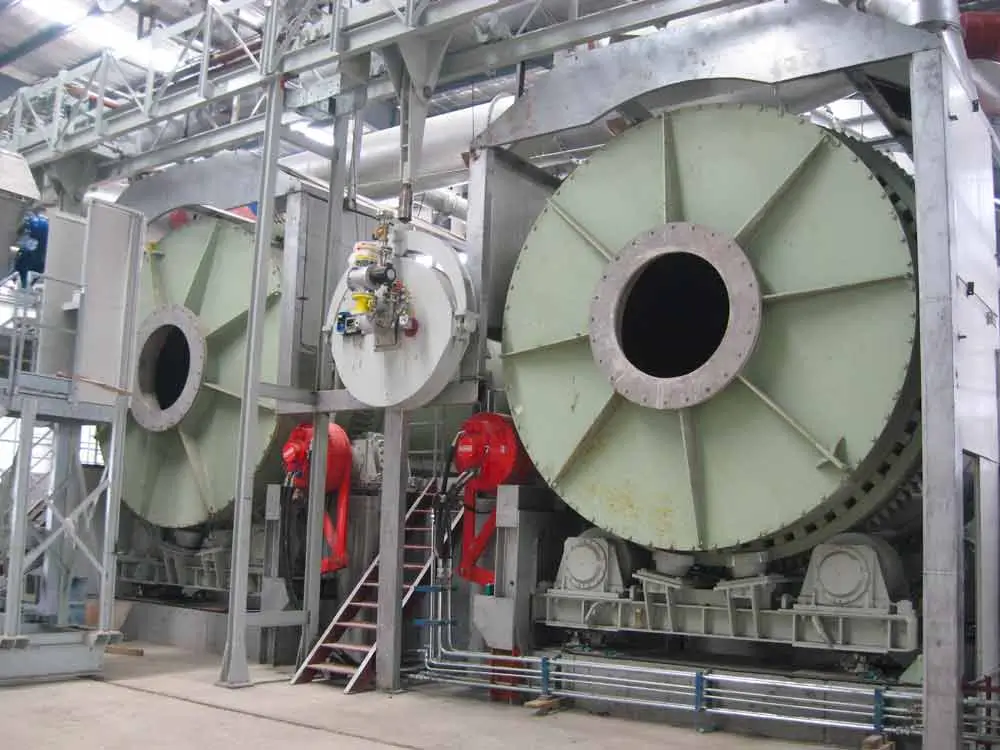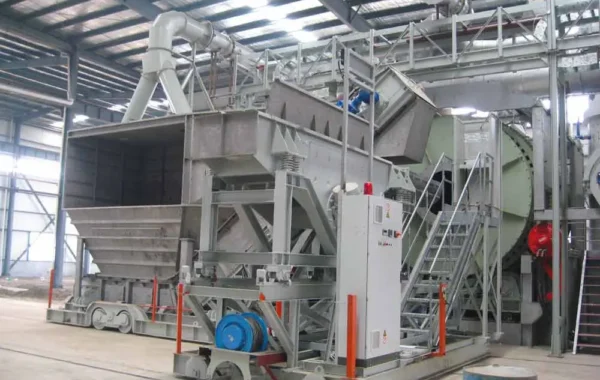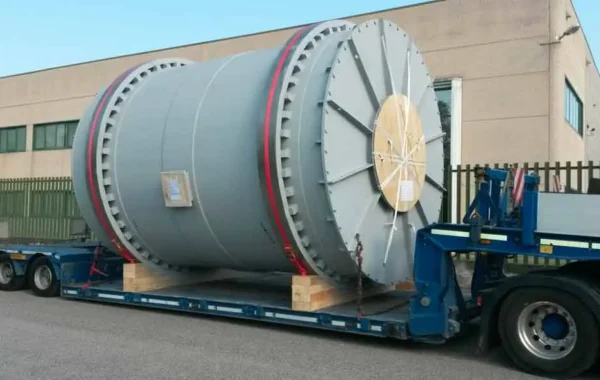In this article we will describe the classic operation of an Aluminium rotary furnace, the benefits it brings to the interior of a recycling plant, and look in detail at the technical specs of the machines produced by GME Recycling and the advantages a company can gain by choosing our machinery.
The importance of an aluminum rotary furnace in the metal recycling industry
In the realm of metal recycling, the Aluminium Rotary Furnace stands out as a crucial component in the process of reclaiming and repurposing aluminium scrap. This innovative piece of machinery plays a pivotal role in the aluminium recycling industry, specifically designed for melting and processing aluminium, enhancing efficiency, and minimizing waste. In this comprehensive article, we will delve into the intricate details of the aluminium rotary furnace, exploring its functionalities, components, and its indispensable role in metal recycling plants.
Aluminium Rotary Furnace Functionality:
The Aluminium Rotary Furnace operates on the principle of high-temperature rotary melting, providing an effective solution for recycling aluminium. Its primary function is to melt aluminium scrap efficiently, facilitating the separation of impurities and transforming the material into molten aluminium ready for reuse. This process is essential for sustainability, as it significantly reduces the demand for primary aluminium production and minimizes environmental impact.
Aluminium Rotary Furnace standard Parts Composition
- Refractory Lining:
At the core of the aluminium rotary furnace lies the refractory lining, which withstands extreme temperatures generated during the melting process. This lining is typically composed of high-quality refractory materials, ensuring durability and longevity.
- Rotary Drum:
The rotary drum is a critical component responsible for the furnace’s distinctive rotating motion. This continuous rotation enhances heat distribution, ensuring uniform melting of the aluminium scrap. The controlled rotation also aids in the separation of dross, promoting a cleaner and more efficient recycling process.
- Burners:
High-efficiency burners are integrated into the design to provide the necessary heat for the melting process. These burners are strategically positioned to optimize energy consumption and ensure a thorough and rapid melting of the aluminium scrap.
- Charging System:
The charging system facilitates the introduction of aluminium scrap into the rotary furnace. Its design ensures a steady and controlled feed of material, preventing overloading and maintaining an efficient melting process.
- Exhaust System:
An effective exhaust system is crucial for managing emissions and maintaining a controlled atmosphere within the furnace. It plays a key role in environmental compliance and ensures the safety of the overall operation.
- Tilting Mechanism:
Some advanced models feature a tilting mechanism that allows operators to control the pouring of molten aluminium. This feature enhances flexibility in the recycling process, enabling precise pouring and minimizing the risk of spillage.
Significance in Metal Recycling Plants
The Aluminium Rotary Furnace holds immense significance in metal recycling plants, particularly in the aluminium recycling sector. Here’s why it is considered a cornerstone in these facilities:
- Efficiency in Aluminium Melting:
The rotary furnace’s design and functionality contribute to a highly efficient melting process. The continuous rotation and optimal heat distribution result in faster melting times, reducing energy consumption and operational costs.
- Dross Recycling:
Aluminium rotary furnaces are specifically designed for effective dross recycling. The rotating motion aids in the separation of dross from molten aluminium, ensuring a cleaner end product and minimizing material wastage.
- Versatility in Handling Various Aluminium Scrap:
These furnaces are versatile and capable of handling a wide range of aluminium scrap, including but not limited to aluminium cans, sheets, and other industrial scrap. This versatility makes them a preferred choice in metal recycling plants with diverse input materials.
- Reduction of Environmental Impact:
By melting recycled aluminium instead of relying solely on primary production, the rotary furnace significantly reduces the environmental impact associated with mining, extraction, and processing of raw materials. This aligns with the global push towards sustainable and eco-friendly practices.
- Energy Efficiency:
The use of high-efficiency burners and the design of the furnace contribute to overall energy efficiency. This not only reduces operational costs but also aligns with the industry’s commitment to sustainable practices.
Discover GME’S aluminium rotary furnaces
The GME’s Aluminium Rotary Furnace boasts an advanced transmission system, meticulously engineered to ensure optimal performance and efficiency in the metal recycling process. Let’s delve into the technical details that make this transmission system a key component of the furnace:
Oven Revolutions
The furnace’s rotary motion is precisely controlled with an impressive range of 0-3 revolutions per minute (rpm). This versatility allows for flexibility in the melting process, accommodating various types and quantities of aluminium scrap.
Transmission by Pinion/Crown Gear M = 35:
The heart of the transmission system lies in the robust pinion/crown gear mechanism, where M = 35 signifies a gear module that contributes to the overall strength and durability of the transmission. This combination ensures a reliable and smooth transfer of power within the system.
Pinion Revolutions:
The pinion, a crucial element in the transmission, operates within a range of 0-18 rpm. This range offers adaptability, allowing for precise control over the melting process and accommodating different operational requirements.
Copy to the Pinion Shaft:
The transmission system is designed to handle substantial loads, with a nominal copy to the pinion shaft at 2400 Kgm and a maximum of 3000 Kgm (at 2 rpm). This robust construction ensures the system’s durability and reliability under varying operational conditions.
Installed Power:
Powering this sophisticated transmission is an installed motor with a capacity of 55 kW. This substantial power output enables efficient and rapid melting of aluminium scrap within the rotary furnace.
Control with Constant Copy Hydraulic Motor and Planetary Gearbox:
The transmission system is intricately linked to a hydraulic control mechanism, featuring a constant copy hydraulic motor and a planetary gearbox. Referencing drawing P012-110, this integration enhances precision and control over the rotary motion, contributing to the overall efficiency of the aluminium melting process.
Hydraulic Power Supply:
Operating at approximately 170 bar, the hydraulic power supply is equipped with a variable flow pump that is hydraulically piloted. This configuration ensures a reliable and adaptable power supply to meet the dynamic requirements of the furnace’s operation.
Reversibility and Continuous Motion:
The transmission system offers the unique capability of reversing motion, including continuous rotation. This feature adds versatility to the furnace’s functionality, allowing for seamless adaptation to different phases of the recycling process.
Acceleration and Deceleration Ramps:
The transmission system incorporates customizable acceleration and deceleration ramps, providing operators the ability to calibrate the starting and stopping phases. This level of control enhances the safety and efficiency of the furnace’s operation.
Negative Parking Brake:
The transmission system includes a negative parking brake on the planetary reduction gear. Importantly, this brake does not rely on an electrical current to close, adding an extra layer of reliability to the overall system.
Benefits in the GME Aluminium fixed Rotary Furnace Process:
- Cost Efficiency (35% Reduction):
One of the primary advantages of GME’s Aluminium Rotary Furnace lies in its remarkable cost efficiency, with a notable reduction of 35%. This financial benefit is a result of streamlined operations, improved energy utilization, and enhanced overall process efficiency, contributing to significant savings in the recycling process.
- Utilization of Organic Residuals as Auto-Thermal Process Fuel:
GME’s commitment to sustainability is evident in its innovative approach to waste management. The organic residuals extracted during the aluminium recycling process are ingeniously repurposed as fuel for the auto-thermal phase. This dual-purpose strategy not only minimizes waste but also contributes to the overall energy efficiency of the furnace, creating a closed-loop system that aligns with eco-friendly practices.
- Enhanced Performance:
The Aluminium Rotary Furnace from GME delivers exceptional performance benefits, particularly during the smelting phase. Zero oxidation of metallic fractions is a key feature, ensuring a superior and cleaner melting process. This reduction in oxidation not only preserves the quality of the recycled aluminium but also enhances the overall efficiency of the furnace, resulting in a high-performance operation.
- Eco-Friendly Operation:
GME prioritizes environmental responsibility, and this is reflected in the eco-friendly design of their Aluminium Rotary Furnace. The inclusion of dedusting bag filters and afterburners is a strategic measure to drastically reduce gases pollution, specifically targeting Total Organic Compounds (TOC). This commitment to minimizing environmental impact aligns with global sustainability goals, making the furnace a responsible choice for environmentally conscious metal recycling.
– Dedusting Bag Filters:
The integration of dedusting bag filters ensures that particulate matter and contaminants are efficiently captured, promoting a cleaner exhaust and minimizing air pollution.
– Afterburners:
Afterburners play a crucial role in further reducing emissions by combusting residual gases, particularly organic compounds. This additional step in the furnace’s design contributes to GME’s dedication to creating a cleaner and safer working environment.
In conclusion, GME’s Aluminium Rotary Furnace not only delivers cost savings through increased efficiency but also champions sustainability through the innovative reuse of organic residuals. Its performance benefits, including zero oxidation of metallic fractions, make it a reliable and high-performing solution for the smelting phase. Furthermore, the furnace’s eco-friendly features, such as dedusting bag filters and afterburners, underscore GME’s commitment to minimizing its environmental footprint in the pursuit of responsible metal recycling.
Comments are closed.




